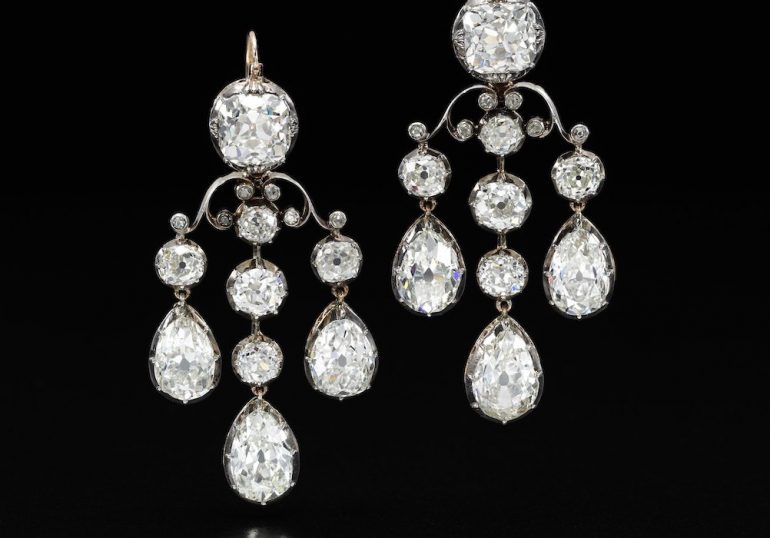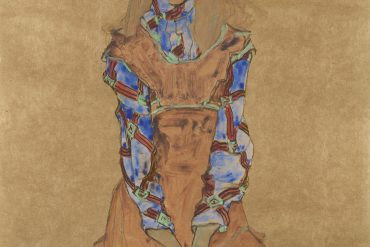One of the most important royal jewelry collections ever to come to auction is set to capture the world’s imagination when it comes for sale at Sotheby’s in Geneva on 14 November 2018. Entitled “Royal Jewels from the Bourbon-Parma Family”, the auction will span centuries of European history, from the reign of Louis XVI to the fall of the Austro-Hungarian Empire, and will offer fascinating insights into the splendor of one of Europe’s most important royal dynasties.
Descended from Louis XIV of France, the Holy Roman Emperors and from Pope Paul III, the Bourbon-Parma family is linked by blood to the most important ruling families of Europe – from the Bourbons to the Habsburgs. Members of the lineage include Kings of France and Spain, Emperors of Austria and the Dukes of Parma. This exceptional ancestry is evidenced in the extraordinary opulence and provenance of the pieces in the collection, led by a breath-taking group of jewels which once belonged to Marie Antoinette (1755–1793), ill-fated queen of France, which have not been seen in public for 200 years, as well treasures from her brother-in-law, King Charles X of France (1757-1836), the Archdukes of Austria and the Dukes of Parma.
Daniela Mascetti, Deputy Chairman, Sotheby’s Jewelry Europe and Senior International Specialist: “It is one of the most important royal jewelry collections ever to appear on the market and each and every jewel is absolutely imbued with history. Never before seen in public, this extraordinary group of jewels offers a captivating insight into the lives of its owners going back hundreds of years. What is also striking is the inherent beauty of the pieces themselves: the precious gems they are adorned with and the exceptional craftsmanship they display are stunning in their own right.”
JEWELS FROM QUEEN MARIE ANTOINETTE
Never in the course of history has the destiny of a queen been so closely associated with jewels than that of Marie Antoinette. Her great love of pearls and diamonds is well-known and a number of historians have cited Napoleon’s view, that the so-called “affair of the diamond necklace” – a scandal which tarnished the queen’s reputation in 1785 – was one of the causes of the French Revolution.
The impressive ensemble of jewels to be offered this autumn has an extraordinary story. In March 1791, King Louis XVI, Marie Antoinette and their children began to prepare their escape from France. According to accounts written by Marie Antoinette’s lady in waiting, Madame Campan, the queen spent an entire evening in the Tuileries Palace wrapping all of her diamonds, rubies and pearls in cotton and placing them in a wooden chest. In the following days, the jewels were sent to Brussels, which was under the rule of the queen’s sister, Archduchess Marie-Christine and which was home to Count Mercy Argentau. The count, the former Austrian Ambassador to Paris, was one of the only men who had retained the queen’s trust. It was he who took delivery of the jewels and sent them on to Vienna, into the safe keeping of the Austrian Emperor, Marie Antoinette’s nephew.
In 1792, the royal family was imprisoned in the Temple tower. Louis XVI and Marie Antoinette were executed by guillotine in 1793 and their 10-year old son, Louis XVII, died in captivity. The king and queen’s only surviving child, Marie-Thérèse de France (1778-1851), “Madame Royale”, was released in December 1795, after three years of solitary confinement. After learning of the deaths of her mother and brother, she was sent to Austria. Upon her arrival in Vienna in 1796, she was given her mother’s jewels by her cousin, the emperor. Having borne no children of her own, Madame Royale bequeathed part of her jewelry collection to her niece and adopted daughter, Louise of France (1819–1864), Duchess of Parma and grand-daughter of Charles X, King of France (1757-1836), who in turn left them to her son, Robert I (1848-1907), the last ruling Duke of Parma.
Altogether, the collection includes 10 jewels which belonged to Marie Antoinette.
In addition to the exquisite pearl jewels announced in June, which includes a stunning diamond pendent, supporting a natural pearl of exceptional size (26 mm x 18 mm), and a fabulous necklace featuring 119 natural pearls, the sale will also offer a beautiful pair of natural pearl and diamond earrings, and a superb single-strand natural pearl necklace.
This beautiful six-strand pearl necklace also provides a direct link to the iconic queen of France. Its clasp – which remains unaltered today – was part of her collection, and features five large and 18 smaller natural pearls. In Marie Antoinette’s day, it formed the clasp of a six-row natural pearl bracelet, one of a pair. The necklace was commissioned by later generations of the Bourbon Parma family and strung with cultured pearls.
Five fascinating diamond jewels to be auctioned in November can be traced back to Marie Antoinette. Among them is a stunning diamond brooch from the late 18th century, featuring a beautiful yellow diamond. The double ribbon bow was formerly part of Marie Antoinette’s collection, and it is thought that the yellow diamond pendant was added at a later date.
Created as a memento, a diamond ring bearing initials MA for Marie Antoinette and containing a lock of her hair provides a fascinatingly intimate link to the queen (illustrated left). It is offered together with a ring with the monogram and hair of her father-in-law, Louis, Dauphin of France (1729-1765) who died before he could ascend the throne, and a diamond plaque bearing the monogram MT set in diamonds, which refers to Marie-Thérèse of Savoie (1803-1879), Duchess of Parma and wife of Charles II, Duke of Parma.
By family tradition, the diamonds adorning this beautiful brooch belonged to Marie Antoinette. In her detailed inventory of the family’s jewels, Maria Anna of Austria (1882-1940), explains she was informed of the history of the brooch by her father-in-law, Robert I of Parma (1848-1907), who presented it to her on the occasion of her engagement to his son, Elie de Bourbon Parme (1880-1959).
Also passed down through generations of Marie Antoinette’s descendants is a diamond ring decorated with her portrait, made in the late 18th century. In her will, Marie Antoinette’s daughter, Marie Thérèse de France (also known as Madame Royale), mentions that the portrait, which is set within a frame of pearls, is a likeness of her mother.
Marie Antoinette’s passion for Jewelry also extended to fine watches, as is evidenced by this pocket watch. Although the movement of the watch has been changed, its case – in blue enamel and encrusted with pearls – belonged to the queen. It bears the initials M.A. on the inside of the case, along with three fleur de lys motifs.
JEWELS FROM THE FRENCH ROYAL FAMILY
The collection is also highlighted by jewels that belonged to King Charles X (1757-1836), the last King of France and last of the Bourbon rulers, his son, the Duke of Angoulême and their descendants. Resolutely conservative, accused by his own brother Louis XVI of being “plus royaliste que le roi” (more royalist than the king), Charles X revived a number of orders of chivalry which had been abolished during the French revolution and under Napoleon’s rule.
This breathtaking diamond tiara offers a fascinating insight into how precious objects were disassembled in order to retrieve diamonds and gemstones, so they could be re-used as fashions evolved.
The diamonds which adorn the tiara came from a badge of the Royal Order of the Holy Spirit, a French order of chivalry founded by King Henri III in 1578. The insignia was originally owned by Charles X, Marie Antoinette’s brother-in-law. The diamonds later passed to Robert I, Duke of Parma (1848-1907). The tiara was created using the precious stones around 1912 for Archduchess Maria Anna of Austria (1882-1940) by the celebrated Vienna jeweler Hübner, who designed it to allow the wearer to explore different styles: the fleur de lys motifs of this stunning piece can be detached and worn separately as brooches. The frame of Charles X’s order (illustrated above left), which originally held the diamonds, has remained in the family and will also be offered in November.
Extraordinary in its workmanship and powerful symbolism, this jeweled badge of the Order of the Golden Fleece (illustrated right) belonged to Louis Antoine of Bourbon, Duke of Angoulême (1775-1844), who married Marie-Antoinette’s daughter, his cousin.
The Order of the Golden Fleece is widely considered to be the most prestigious and exclusive order of chivalry in the world. It is likely that Louis Antoine received the badge following his participation in the Spanish Expedition of 1823, thanks to which his cousin, Ferdinand of Bourbon was restored as absolute king of Spain. A sumptuous example of the order’s symbol, beneath a large white diamond this badge features the traditional French royal symbol, the oriflamme, represented by a central sapphire, surrounded by flames composed of rubies. The fleece of the ram forms the lower part of the jewel, realized in gold and diamonds.
Boasting the same extraordinary provenance, this plaque of the Royal Order of the Holy Spirit (right) was awarded to Louis Antoine, Duke of Angoulême before being passed down through the generations to Robert I, son of Charles III of Parma and Louise de France (and Marie Antoinette’s great-nephew). The most prestigious French order of chivalry during its 252 years of existence (1578-1830), it was abolished during the French Revolution, and then revived by Charles X who restored the ceremonies of the Order. The loop at the top of the badge (adorned with baguette- and round-cut diamonds) was designed so that the order could be worn on a tie without having to alter the jewel.
ROYAL TREASURES OF AUSTRIA
From a separate branch of this prestigious family, the collection to be offered in November will also include sumptuous jewels passed down through the Bourbon-Parma family from the imperial family of Austria.
This beautiful Burmese ruby and diamond set, composed of a brooch and a pair of earrings, dates from the turn of the last century. It conjures up images of the glamour and elegance of the Austrian court. Originally part of the collection of Queen Isabella II of Spain (1830-1904), the set was later purchased by Archduke and Archduchess Frédéric of Austria and inherited by their daughter, Maria Anna, Archduchess of Austria (1882-1940), who mentions it in her inventory of the family jewels.
A diamond bow brooch from the 18th century also stands out among the jewels from the Austrian side of the Bourbon-Parma family. It originally belonged to Empress Marie Thérèse of Austria (1717-1780), Marie Antoinette’s mother, and later to Archduke Rainier of Austria (1827-1913) before passing down through the family to Maria Anna. Its intricate design and workmanship illustrate the quality of jewels created for the royal family.
In her inventory, Maria Anna recorded that this delightful diamond brooch, with a yellow sapphire in its centre (illustrated right), originally belonged to her mother, Princess Isabella of Croÿ (1856- 1931). Maria Anna received these simple yet elegant diamond earrings (left) from her father, Archduke Frédéric, on the occasion of her wedding in 1903.
Highlights of the collection will go on view around the world this autumn:
30-31 October, at The Sherwood Taipei
10-14 November, at Mandarin Oriental, Geneva
All images courtesy Sotheby’s.
Discuss in Kanban.


























